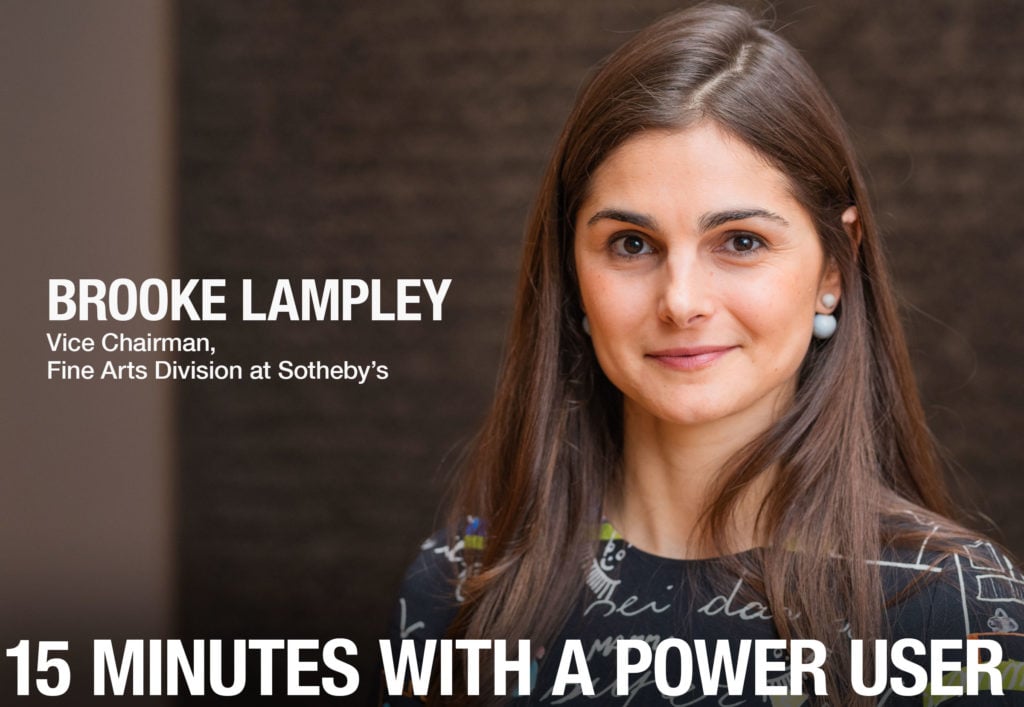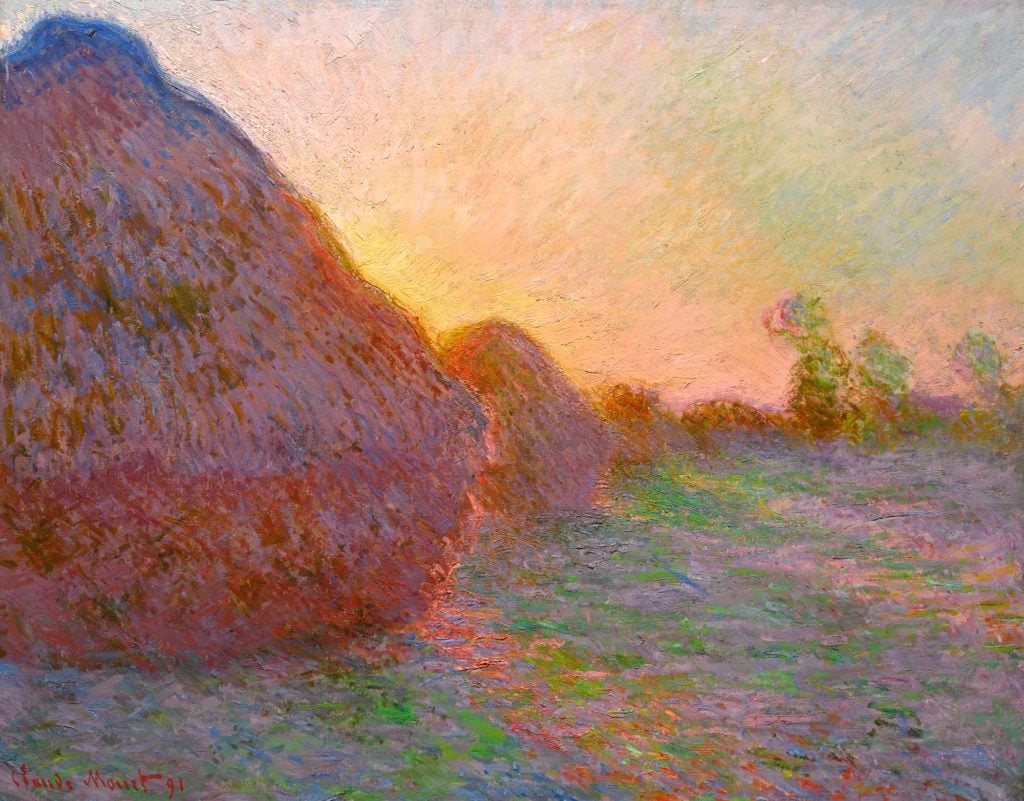15 Minutes With a Power User: Brooke Lampley


Artnet Price Database Team

There is only one tool trusted by art world insiders to buy, sell, and research art: the artnet Price Database. Those who use the database—auction houses, museums, galleries, government institutions, and more—represent the art world’s most important players.
In a new series, we’re taking 15 minutes to chat with some of the artnet Price Database’s power users to get their take on the current state of the market, and how they’re keeping up with the latest trends.
We caught up with Brooke Lampley, who joined Sotheby’s as vice chairman of the fine arts division early last year. Previously, Brooke was at Christie’s, where she was the head of Impressionist and Modern Art, managing auction sales totaling over $1 billion annually. Ahead of the marquee Impressionist and Modern sales at Sotheby’s in mid-May, we had a wide-ranging conversation with Brooke about a changing of the guard in auction houses, what great private collections of the future will look like, and more.
Brooke, you joined Sotheby’s in early 2018 after a long career at Christie’s. Specialists used to choose a house and become lifers, but now that career trajectory is clearly different. Why do you think this is?
I think the real story is the uncommon fidelity and loyalty of specialists in this field. In any other industry, it is incredibly unusual for a professional to stay with the same company for decades. The fact that the auction houses have traditionally been able to retain specialists and executives for decades is anomalous, and a testament to the unique allure and unlimited development potential of working at an auction house. To me, it is a distinctive facet of the expertise-led career track that a specialist can continue to learn and grow within the same role by accumulating experiences and exposure to more art, growing their network of clients and increasing their acumen as advisors. Specialists are encouraged and find it attractive to stay at the company because tenure itself delivers growth in the form of deepening expertise. I transitioned because I was excited by the commitment to innovation and technology that I saw at Sotheby’s, which I believe is the key to providing the best customer service to our clients now and in the future.
The fact that the auction houses have traditionally been able to retain specialists and executives for decades is anomalous, and a testament to the unique allure and unlimited development potential of working at an auction house.
In your career to date, what is your favorite artwork to come across the auction block?
In the past two decades, one of the most notable market changes has been the shift in appreciation from early Impressionist works dating to the early 1870s, to later works, which directly influenced the emergence of Modern avant-garde art in the 20th century. The engine of this change has been a profound reevaluation of Monet’s series works where he examined the transient effects of time of day and weather on a fixed subject such as haystacks, the Rouen Cathedral and ultimately waterlilies on his pond in Giverny over the course of days, months, or even years. I have been privileged to bring a number of these paintings to market; in 2016, I oversaw the sale of—and directly underbid—a haystack which set a new record for the artist at auction. This spring at Sotheby’s, we will offer another example from the haystacks series, which may reset the record again. Now the most celebrated works of Monet’s oeuvre, the series’s pictures are sought after by Impressionist and contemporary collectors alike. It is not only a sublime example from the series, but also a consummate example of Impressionist painting at its finest. This is a painting that showcases Claude Monet as an unparalleled landscape painter, and a radically innovative conceptual artist who would influence generations of artists to come.

Claude Monet, Meules (1890). Courtesy Sotheby’s.
Are there any memorable lots that really surprised you, in terms of how much or how little they sold for, or the level of interest?
That’s an easy one. In my early days, I ran the mid-season sales of Impressionist and Modern Art for a couple seasons. My first season as head of sale, I was gifted with the consignment of a remarkable little collection from an estate in Washington D.C., which included a very large and fully realized gouache by the little-known Dada artist Hannah Hӧch, titled Mechanischer Garten. The work had recently been exhibited at the major Dada and Surrealism survey exhibition at the National Gallery of Art and at MoMA. However, the auction record for the artist was only $12,000, so the work received a pre-sale estimate of $8,000-12,000 in recognition of its superior quality.
I decided to put the work on the cover of the catalogue, and from the moment we started marketing the sale, the interest calls were coming in fast and furious. All of the most important dealers in the Surrealist field were calling me trying to gauge interest levels and prepare their bidding strategies. When I told one famous dealer that I thought they should prepare to bid in excess of $100,000, they were shocked and instructed me that the previous world record for the artist was only $12,000, which of course I knew well. I had to reply simply and modestly that I was in a unique position to know the interest levels on the work and just trying to give them my best advice. On the actual day of the sale, there were so many bidders registered to bid by phone that we were concerned there would not be enough staff in the building available to facilitate all of the bids! Ultimately, there were over 20 bidders participating and three who exceeded $300,000. The work sold for $824,000. I couldn’t possibly have known that it would sell for that much. It is a perfect example of the unique ability of auction to achieve unprecedented prices for rare and irreplaceable works of art.
To me, there are two very obvious trends that will differentiate the great collections of the future. One is that the art world is nurturing a more holistic narrative of art history that is intentionally inclusive… the second is the natural progress of our visual lexicon.
Modigliani’s Nu couché, offered in Spring 2018 with a splashy marketing campaign, hammered under its estimate of $150 million. Do you think it was mis-priced, or was there simply a lack of desire for the lot? What does this mean for other masterworks in the category?
Nu couché sold for $157.2 million last May, which marked the highest-ever auction price for any work of art sold in Sotheby’s 275-year history. Even as auction prices continue to reach tremendous new heights, the price is extraordinary by any measure.
That said, precedent is a double edged-sword in the auction market. In the case of this Modigliani, the centerpiece of a recent retrospective at the Tate Modern, there was a price comparable of another reclining nude from the series that had recently been estimated in excess of $120 million and ultimately sold for $180 million; with this example in mind, the seller wanted to start the bidding at a higher price than $120 million and secure a price of $150 million while still allowing the possibility for competition beyond that level. This reflects the great strength of the market and reasonable desire of sellers to present works at auction at the highest possible pre-sale values. However, there is a necessarily limited audience for works above $100 million and one of those collectors who would have been very excited about this work had already bought another similar example. In the days before the sale, there were several clients interested; had just one of those clients ultimately bid the price result could have been utterly different. Such is the magic of auction that it relies on the passionate determination of two bidders competing against each other to establish the fair market value, and on any given day, depending on what is happening in the lives of those individuals, the results can differ. It was still an outstanding result for a truly remarkable painting.
Great private collections of the past century such as that of David Rockefeller, which Christie’s sold last spring, were largely comprised of Impressionist and Modern works. As someone who works very closely with collectors, how do you think the next generation will achieve their own kind of legacy? What will the collection of the millennial David Rockefeller look like?
To me, there are two very obvious trends that will differentiate the great collections of the future. One is that the art world is nurturing a more holistic narrative of art history that is intentionally inclusive and celebrates the art of those who have historically been undervalued, such as artists of African descent and female artists, to name a few. The second is the natural progress of our visual lexicon—where once our children grew up learning about Monet, they now learn just as much about Rothko, Warhol, and Koons. So naturally the collections of the future will embrace most abstract art, more new media, and more conceptual enterprises.
What is the last thing you searched for on the artnet Price Database?
I could answer this question on a minute to minute basis! But I just looked at the top prices for Picasso in descending order, a pretty typical search for me. I spend a lot of time hypothesizing about the records to come.
The artnet Price Database is the only art market research tool trusted by collectors, top auction houses, blue-chip galleries and institutions around the world. To learn more and subscribe, click here.